I just wanted to see what were the main flights in Asian countries, following a viz I saw of the same for Europe.
Opensky published their “Crowdsourced air traffic data from the OpenSky Network 2019–2021” and I will only use the 2019 data, to focus on the situation before the pandemic.
2 IACO codes
Both origin and destination fields of the data use a 4-letter code
which correspond to IACO codes. It makes data cleaning easier as, as
opposed to IATA codes based on the airport name, IACO codes are based on
the country/region the airport is located in.
My first approach was to refer to the map below to select the correct country codes, but I then went through Wikipedia pages on the topic and just extracted all airports 4-letter codes, instead of focusing on the 2 first characters.

asia_iaco <- read_csv("iaco_asia.csv", col_types = "cf") %>%
mutate(
country = str_replace(country, "Hong Kong", "China"), ## Because rnaturalearth doesn't recognise HK
country = str_replace(country, "Macau", "China"), ## Nor Macau
)
head(asia_iaco)
| iaco | country |
|---|---|
| RCAY | Taiwan |
| RCBS | Taiwan |
| RCCM | Taiwan |
| RCDI | Taiwan |
| RCFG | Taiwan |
3 Data loading
The complete worldwide dataset for 2019 is 2.3 GB. Compressed.
Dataset full size: 5.75GB
opensky <- list.files("./raw_data/", pattern = "*.csv", all.files = TRUE, full.names = TRUE)
flights <- opensky %>%
lapply(read_csv, col_types = "cccccccTTDdddddd") %>%
bind_rows()
flights %>% head() %>% print()
| # | callsign | number | icao24 | registration | typecode | origin | destination |
|---|---|---|---|---|---|---|---|
| 1 | HVN19 | 888152 | YMML | LFPG | |||
| 2 | CCA839 | 780ad1 | YMML | LEBL | |||
| 3 | CES219 | 780b7e | B-5936 | A332 | YSSY | EDDF | |
| 4 | AEA040 | 34444e | EC-LVL | A332 | LEMD | LEMD | |
| 5 | CXA825 | 780d75 | B-2760 | B788 | YSSY | LFPG | |
| 6 | TGW700 | 76bcca | 9V-OFJ | B788 | RJBB |
## # … with 9 more variables: firstseen <dttm>, lastseen <dttm>, day <date>,
## # latitude_1 <dbl>, longitude_1 <dbl>, altitude_1 <dbl>, latitude_2 <dbl>,
## # longitude_2 <dbl>, altitude_2 <dbl>
print(glue::glue("The total dataset contains {prettyNum(dim(flights)[1],big.mark=',',scientific=FALSE)} observations!"))
## The total dataset contains 30,989,481 observations!
This does take a long time to load but includes a lot of observations we are not interested in. Let’s clean that
flights %>%
filter(
origin %in% asia_iaco$iaco,
destination %in% asia_iaco$iaco,
origin != destination
) %>%
left_join(asia_iaco, by = c("origin" = "iaco")) %>%
left_join(asia_iaco, by = c("destination" = "iaco")) %>%
rename(
country_origin = country.x,
country_destination = country.y
)-> asia_flights
head(asia_flights) %>% knitr::kable(format = "pipe")
| callsign | number | icao24 | registration | typecode | origin | destination | firstseen | lastseen | day | latitude_1 | longitude_1 | altitude_1 | latitude_2 | longitude_2 | altitude_2 | country_origin | country_destination |
|---|---|---|---|---|---|---|---|---|---|---|---|---|---|---|---|---|---|
| SVA872 | NA | 710058 | HZ-AK16 | B77W | WIII | RPLL | 2018-12-31 04:00:49 | 2019-01-01 05:54:59 | NA | -6.123714 | 106.63216 | 0.0 | 14.49194 | 120.98954 | 99.06 | Indonesia | Philippines |
| IGO2134 | NA | 800d34 | NA | NA | VOBL | VOMM | 2018-12-31 14:59:40 | 2019-01-01 00:55:29 | NA | 13.206218 | 77.72750 | 914.4 | 12.98547 | 80.15649 | -38.10 | India | India |
| IGO748 | NA | 800c97 | NA | NA | VOMM | VABB | 2018-12-31 15:02:13 | 2019-01-01 05:50:15 | NA | 12.982907 | 80.15914 | -304.8 | 19.08842 | 72.84889 | -22.86 | India | India |
| JSA761 | NA | 76aa6b | 9V-JSK | A320 | WMKK | RPLL | 2018-12-31 15:17:09 | 2019-01-01 01:59:12 | NA | 2.742532 | 101.67454 | 0.0 | 14.49335 | 120.99196 | 45.72 | Malaysia | Philippines |
| UAL151 | NA | a9d5e7 | N73278 | B738 | RPLL | RJBB | 2018-12-31 15:57:43 | 2019-01-01 00:45:55 | NA | 14.519440 | 121.03908 | 0.0 | 34.42145 | 135.19557 | -68.58 | Philippines | Japan |
| IGO872 | NA | 800716 | VT-IFA | A320 | VIDP | VOMM | 2018-12-31 17:11:23 | 2019-01-01 00:13:45 | NA | 28.568270 | 77.07949 | 304.8 | 12.98184 | 80.14671 | 22.86 | India | India |
This gives us almost what we want. One qui modification will be to group flights by routes rather than by origin-destination pair. A Tokyo-Fukuoka flight should be grouped with its counterpart.
asia_flights %>%
mutate(
route = if_else(origin <= destination, paste0(origin, destination), paste0(destination, origin))
) %>%
group_by(country_origin, country_destination, route) %>%
summarise(
counter = n(),
longitude_origin = median(longitude_1, na.rm = TRUE),
latitude_origin = median(latitude_1, na.rm = TRUE),
longitude_destination = median(longitude_2, na.rm = TRUE),
latitude_destination = median(latitude_2, na.rm = TRUE),
) -> asia_flights_summary
asia_flights_summary %>% head() %>% knitr::kable(format = "pipe")
| country_origin | country_destination | route | counter | longitude_origin | latitude_origin | longitude_destination | latitude_destination |
|---|---|---|---|---|---|---|---|
| China | China | VHHHVHSK | 829 | 113.9129 | 22.29801 | 114.1494 | 22.29666 |
| China | China | VHHHVMMC | 196 | 113.9098 | 22.30003 | 113.6387 | 22.15329 |
| China | China | VHHHZBAA | 27 | 113.9374 | 22.30907 | 116.5634 | 39.86545 |
| China | China | VHHHZBHD | 1 | 114.4551 | 36.54492 | 113.8526 | 22.29630 |
| China | China | VHHHZBNY | 6 | 113.9245 | 22.30476 | 116.6393 | 39.85443 |
| China | China | VHHHZGGG | 37 | 113.9208 | 22.30508 | 113.3811 | 23.16518 |
4 Time for a rough viz
Let’s have a first look at the graphs
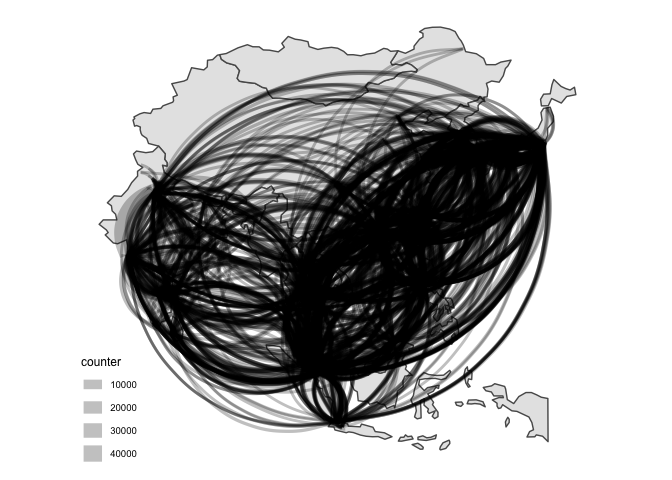
We’d better split that by country of origin.
asia_flights_summary %>%
filter(longitude_origin > 0) %>%
arrange(desc(counter)) %>%
group_by(country_origin) %>%
mutate(ranking = row_number()) %>%
ungroup() %>%
filter(ranking <= 10) -> graph_ready_data
for (ctry in unique(graph_ready_data$country_origin)){
g <- graph_ready_data %>%
filter(country_origin == ctry) %>%
ggplot() +
geom_sf(data = ne_countries(country = ctry, returnclass = "sf", scale = "medium")) +
geom_curve(
aes(
x = longitude_origin, xend = longitude_destination,
y = latitude_origin, yend = latitude_destination,
size = counter, colour =
),
lineend = "round"
) +
theme_map() +
labs(
title = glue::glue("Top 10 flights starting from {ctry}")
) +
theme(
legend.position = "none"
)
print(g)
}
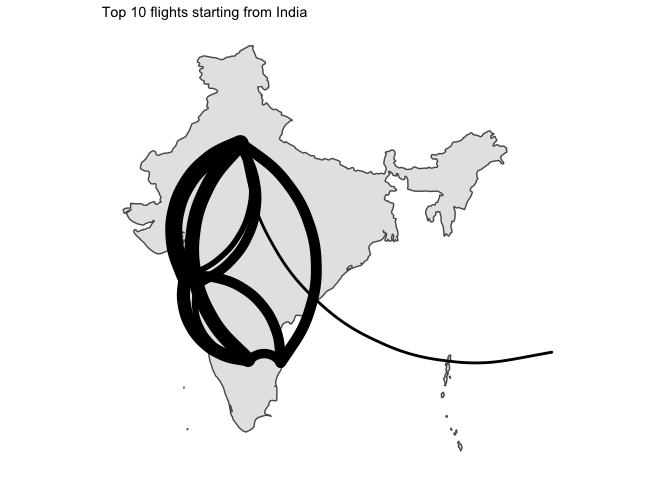
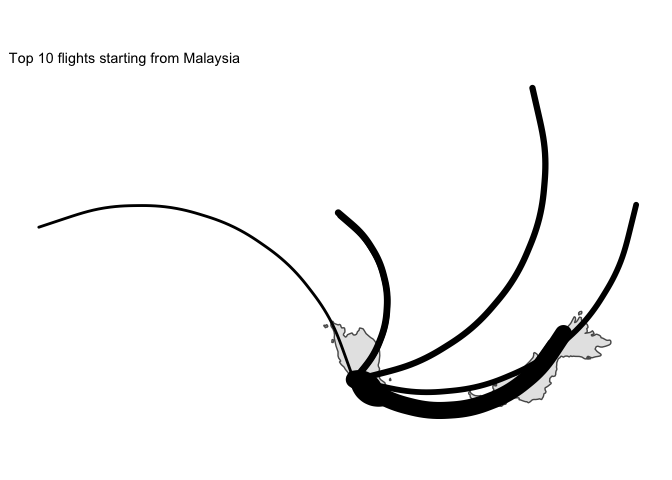
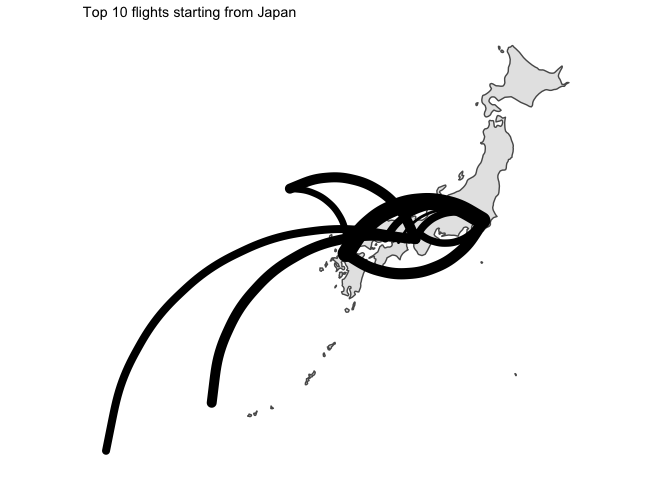

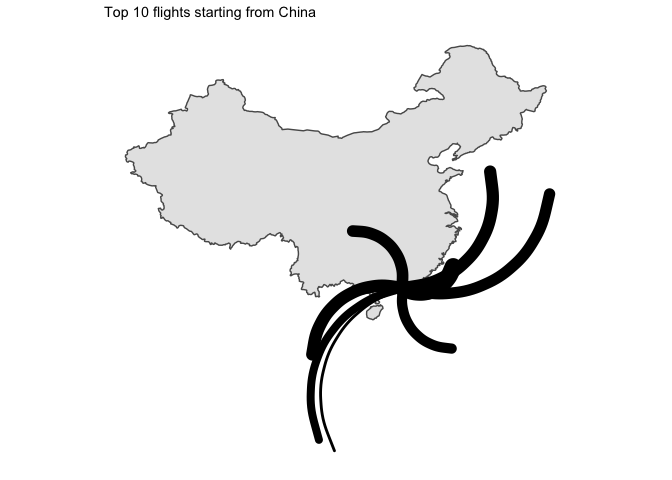
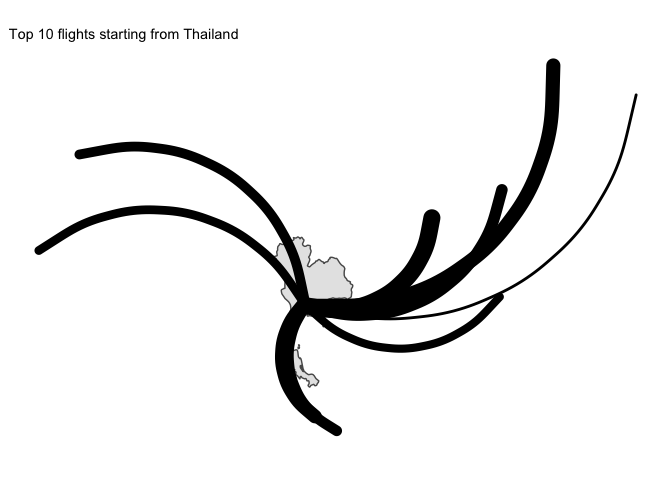
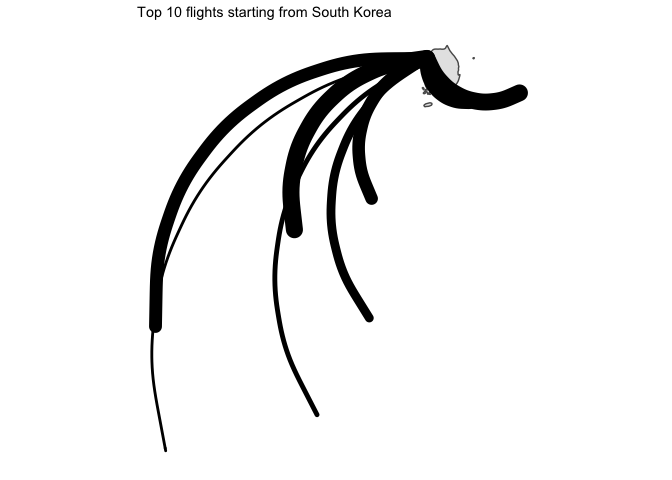
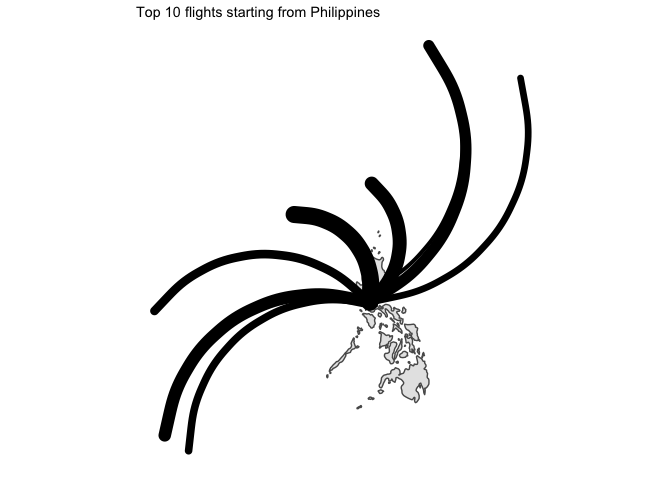
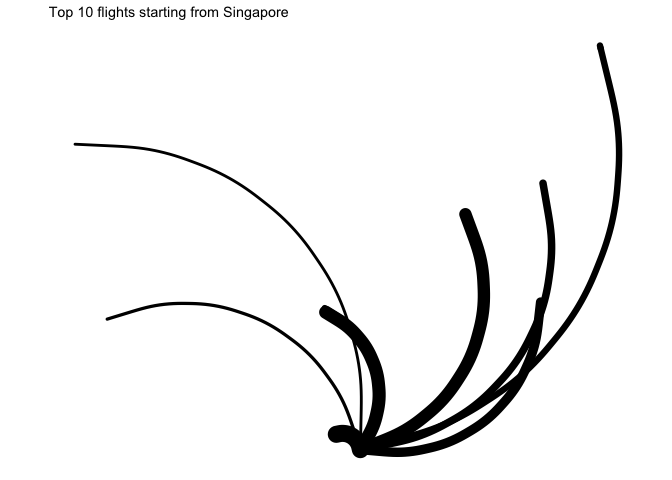
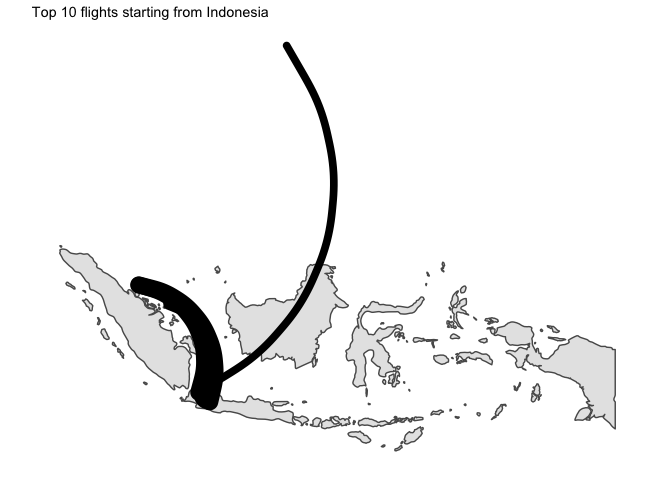

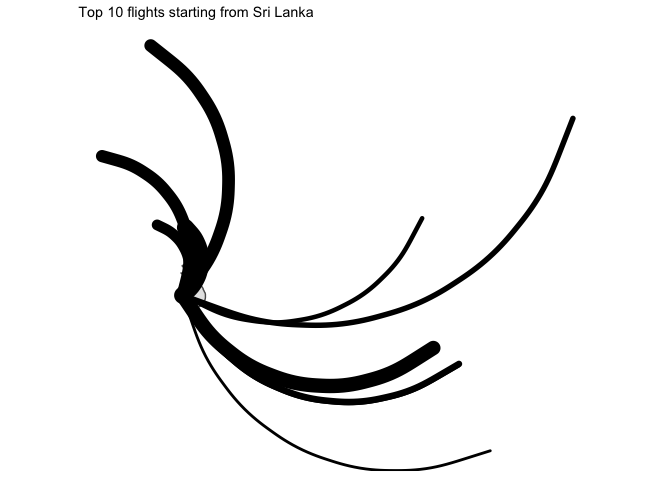
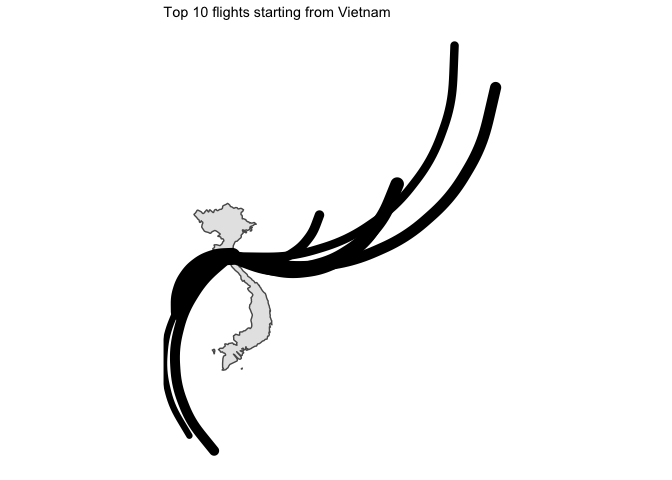
I… kind of like the way it looks ? But without seeing the destination country, that is not that useful.
asia_flights_summary %>%
filter(longitude_origin > 0) %>%
arrange(desc(counter)) %>%
group_by(country_origin) %>%
mutate(ranking = row_number()) %>%
ungroup() %>%
filter(ranking <= 20) -> graph_ready_data
for (ctry in unique(graph_ready_data$country_origin)){
all_ctry <- graph_ready_data %>% filter(country_origin == ctry) %>% select(country_destination) %>% unique() %>% pull(country_destination)
g <- graph_ready_data %>%
filter(country_origin == ctry) %>%
ggplot() +
geom_sf(data = ne_countries(country = all_ctry, returnclass = "sf", scale = "medium")) +
geom_curve(
aes(
x = longitude_origin, xend = longitude_destination,
y = latitude_origin, yend = latitude_destination,
size = counter, colour = country_destination
),
lineend = "round", alpha = 0.33
) +
theme_map() +
labs(
title = glue::glue("Top 10 flights starting from {ctry}")
) +
theme(
legend.position = "none"
)
print(g)
}

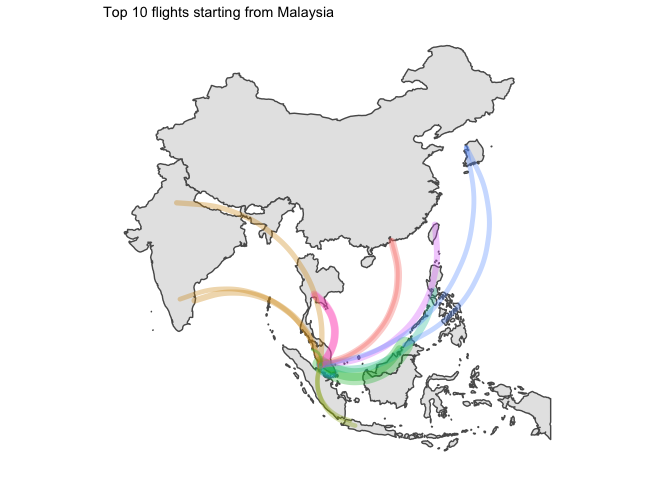
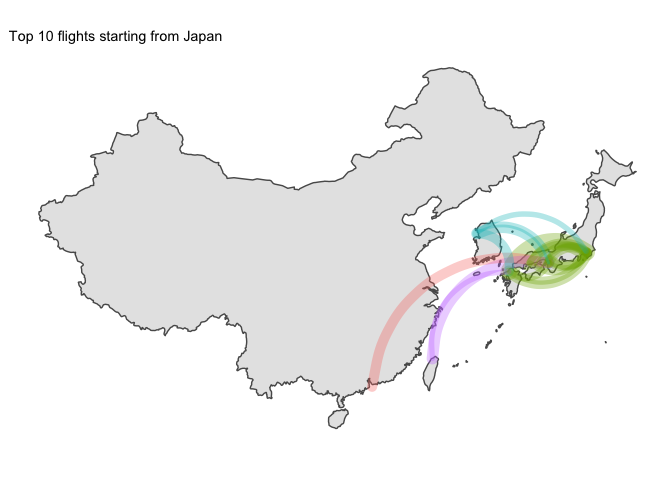
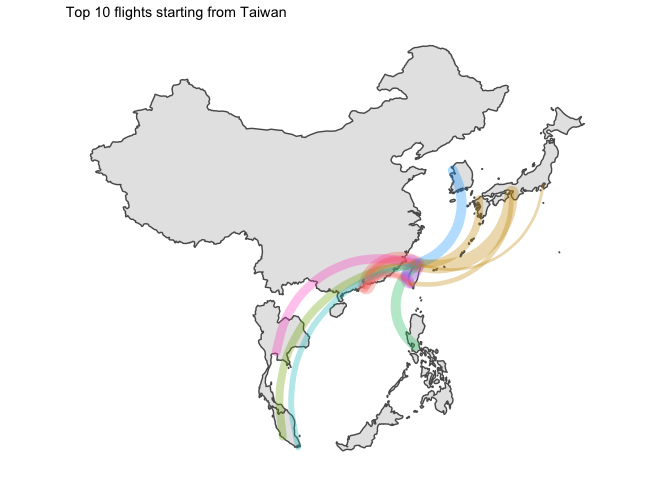
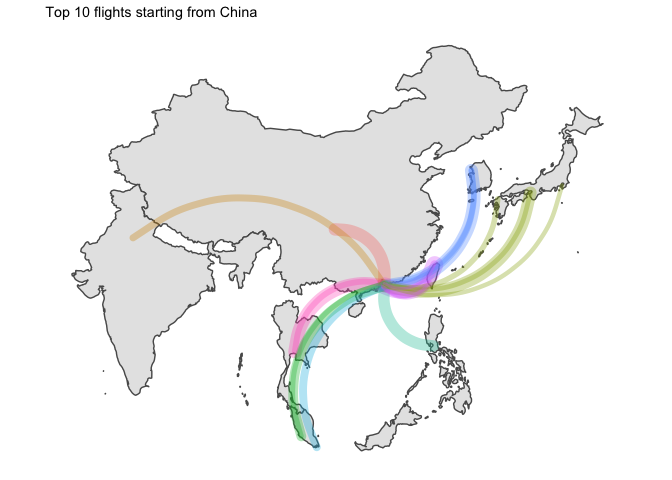
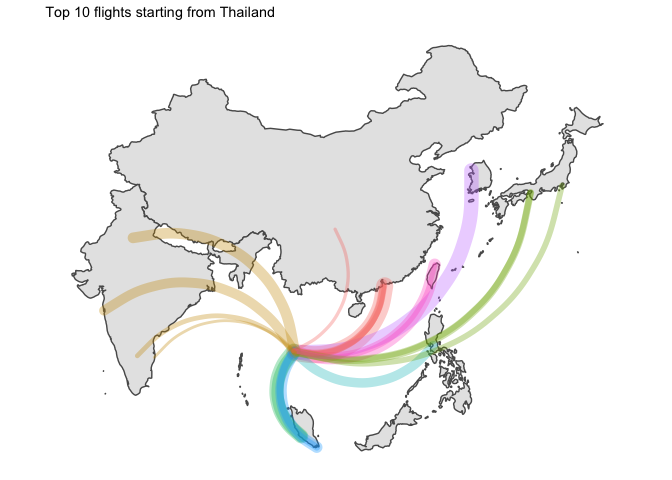

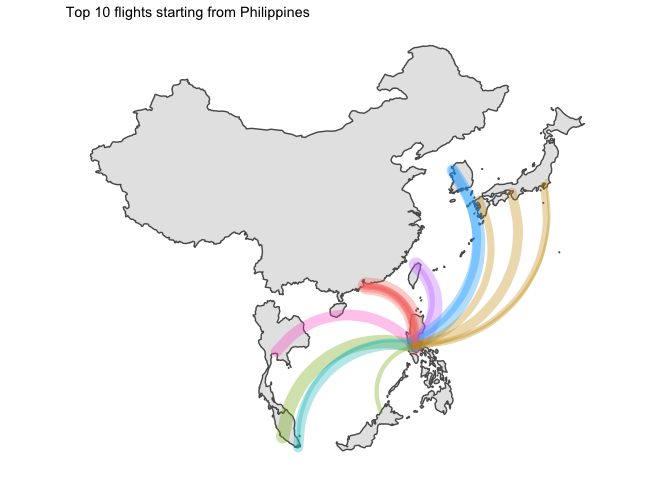
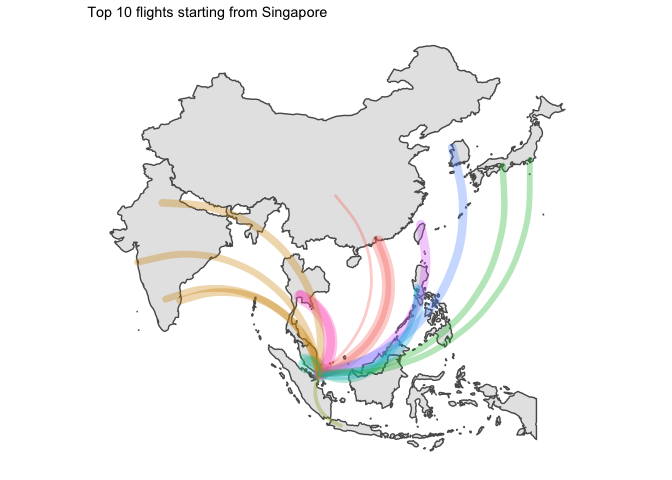


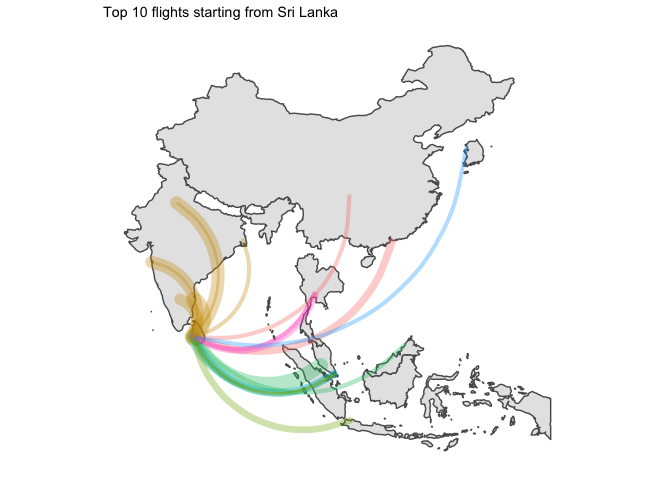
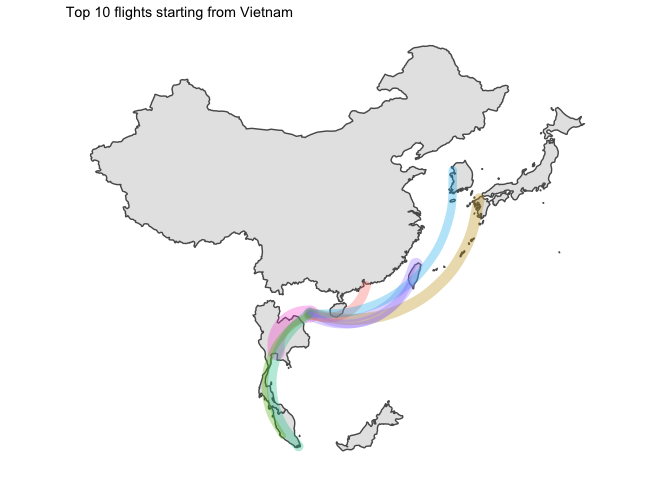
5 Final word
Not much to say. This was a quick and dirty data playground to take my mind off of life.
Two points of interest:
- Japan was the only country which had domestic flights in its top 10 routes
- I am disappointed by the lack of data for China. Only available flights are for HK which leaves most of the country blank…